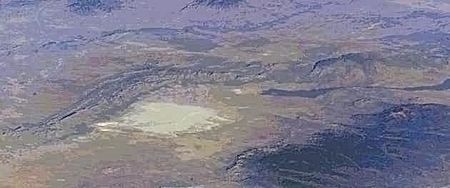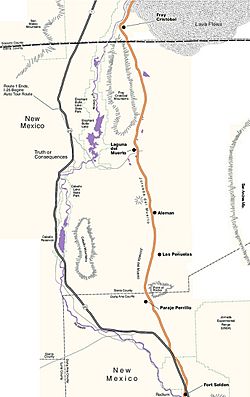Jornada del Muerto facts for kids

The Tularosa Basin is the lower half of the image, with the dark streak of lava north of White Sands the Carrizozo Malpais. The Trinity atomic site is northwest of the Malpais. The forested Sacramento Mountains are to the right-east.
The name Jornada del Muerto translates from Spanish as "Single Day's Journey of the Dead Man" or even "Route of the Dead Man, though the modern literal translation is closer to "The Working Day of the Dead". It was the name given by the Spanish conquistadors to the Jornada del Muerto Desert basin, and the particularly dry 100-mile (160 km) stretch of a route through it from Las Cruces to Socorro, New Mexico. The trail led northward from central Spanish colonial New Spain, present-day Mexico, to the farthest reaches of the viceroyalty in northern Nuevo México Province (the area around the upper valley of the Rio Grande). The route later became a section of the Camino Real.
Natural history
The Jornada del Muerto desert is a wide and long stretch of flat desert landforms and xeric habitat about 100 miles (160 km) from north to south. The desert runs between the Oscura Mountains and San Andres Mountains on the east, and the Fra Cristóbal Range and Caballo Mountains on the west. The western mountains block access to the Rio Grande, the most reliable water source in the region. It is one of the northernmost parts of the Chihuahuan Desert ecoregion in the deserts and xeric shrublands biome.
The Jornada del Muerto Desert remains almost entirely uninhabited and undeveloped to the present day. Located just to the east of the southernmost region of the desert is the Jornada Basin LTER station, used for study of desert ecology, land management, plant physiology, and related topics.
Volcanism
The Jornada del Muerto volcano and malpaís are located at the northern end of the desert's region and basin. The Jornada del Muerto Volcano is a shield volcano that erupted about 760,000 years ago, reaching an elevation of 5,136 ft (1,565 m). The volcano's lava flow created the large Jornada del Muerto malpaís lava field, about 10 by 15 miles (16 by 24 km), over 170 square miles (440 km2) in size. The eruption produced a slow and viscous a'a lava which leaves a very rough surface, making travel across it quite difficult.
Cultural history
The name Journey of the Dead Man probably originated due to the complete lack of water, grazing, and firewood on the route of the Camino Real de Tierra Adentro through this area. Although quite flat, the Jornada del Muerto took several days to a week to cross and presented great difficulties to the earliest Spanish travelers who were on foot with carts or wagons pulled by oxen.
After passing the "Jornada del Muerto" the earliest Spanish encountered, not the Seven Cities of Cíbola, but the humbler walled villages of the Pueblo dwellers, who had a well-developed agriculture and a peaceable tradition. At the first crossing the Jornada del Muerto in 1598 they named the first pueblo they came to Socorro (Spanish for 'help' or 'assistance').
In 1680, during the Pueblo Revolt, the Spanish settlers were forced to retreat southward, along the Jornada del Muerto, together with Indians from the Isleta and Socorro Pueblos. Of the more than 2000 who left Socorro fewer than 1200 survived the crossing. The survivors resettled on the Rio Grande around and just south of El Paso del Norte, 'the Pass to the North', which is now separated between the Mexican city of Ciudad Juárez, Chihuahua, and the U.S. city of El Paso, Texas. In 1692, Diego de Vargas led a new group of settlers north across the Jornada del Muerto to resettle northern New Mexico.
On horseback, the Jornada could be crossed in a couple of days, as described by Bishop Tamarón traveling north on his visitation to New Mexico in 1760. Leaving the Paraje de Robledo, traveling five leagues:
On this day, the twelfth of the month and the sixth of the journey, we came to the Jornada del Muerto. To prepare for it, a detour is made to seek the river at a place called San Diego. The night is spent there. Everything necessary is made ready. It is about half a league from the river. Barrels are brought for the purpose. These are filled with water for the people. On the morning of the thirteenth the horses were taken to the river to drink. Somewhat later all the food for the journey was prepared, and at half past seven we left that post with considerable speed, stopping only to change horses. During this interval we ate what there was, and we traveled in this fashion until eight-thirty at night, when we halted opposite the Sierra of Fray Cristobal.
On the fourteenth day of May, the eighth day of our journey, we made an early start. We reached the river at eleven‑thirty. The livestock were so thirsty that they ran to reach the water. After this fashion were the thirty leagues of this difficult stage traveled.
Homesteaders in the 1860s to 1920s tried to ranch in the Jornada del Muerto, digging wells for the cattle. The first well was at Aleman, dug by Lt. John Martin, and it appears to be the last of the homesteads to be abandoned at the end of the 20th century.
Trail
The Jornada del Muerto trail was that part of the Camino Real which when traveling northward departed from the Rio Grande from the Paraje de Robledo, later the site of Fort Selden, just north of Las Cruces, New Mexico. It passed northward up through a gap, between the Selden Hills on the west and Doña Ana Mountains to the east, on to the plain of the Jornada. The last opportunity for filling water barrels and watering stock before passing farther north was from the Paraje de San Diego overlooking the Rio Grande five leagues beyond Robledo and a half league from the River.
The next intermittent water was at Paraje del Perrillo near where the trail passes Point of Rocks which is the southernmost point of the closed Jornada basin. The trail heads basically north through mesquite scrub land to another small intermittent watering place, La Cruz de Alemán, named for a fugitive German merchant who died of thirst there in the 1670s, at a time when it had no water. At that site there are now buildings of the Bar Cross Ranch built on the site of the original settlement in the Jornada del Muerto, the Alemán Ranch, established in 1867.
Further north the trail crosses a number of small ephemeral lake beds the Jornada Lakes, on the way to Engle Lake then known as the Laguna del Muerto. When water was not found in the Laguna del Muerto it could be found to the west at the Ojo del Muerto, a spring in Cañon del Muerto in the southern Fra Cristobal Range nearby to the southeast of the later site of Fort McRae that operated from 1863 to 1876.
At the upper end of the basin the trail was squeezed into the Lava Gate between the Fra Cristóbal Range and the Jornada del Muerto Volcano lava fields. The waterless portion of the trail ends at Paraje de Fray Cristóbal on the Rio Grande, but the trail continued north along the river for five leagues, across a small portion of the Jornada del Muerto Volcano lava fields, which originally reached across the Rio Grande. This large lava field has a very rough surface, making travel across it very difficult. This portion of the trail reached the paraje del Contadero along the Rio Grande south of the Mesa del Contadero. It then passed one of two ways around the Mesa, along the river or over the hills to its east, to a paraje and fords of the Rio Grande known as Val Verde from the 1780s. An extremely large Spanish rancho was later established and a large hacienda was built at the crossing at Val Verde in the early 1820s. However it was abandoned soon after under the pressure of Apache raids and attacks by 1826.
In 1846, Major Philip St. George Cooke and the Mormon Battalion established a wagon road south of San Antonio on an old trail on the west bank of the Rio Grande as far as a few miles above the vicinity of modern Hatch, New Mexico, before turning west to make the route known as Cooke's Wagon Road. Soon after the war ended and the California Gold Rush began, thousands of people were following Cooke's road west to California down the west side of the Rio Grande.
With the American acquisition of New Mexico Territory as a consequence of the Mexican American War, protection of settlements and travel by the U. S. Army on the lower Rio Grande below San Antonio began. Fort Conrad was established in 1851 across the river and a little north of the ford of Valverde, and it was replaced in 1854 by Fort Craig miles below the ford and the Mesa, also on the west bank. Fort Thorn was built on the west bank of the Rio Grande in 1853. It was located where a trail from the Jornada road, established by Forty-niners, crossed the Rio Grande to the west bank at San Diego Crossing to meet Cooke's road three miles above Fort Thorn. These offered some protection on the Jornada road and also on the Fort Craig - Fort Thorn Wagon Road down the west side of the Rio Grande to Fort Thorn. This road was also the route of supply for the forts. This Army protection, and the supply columns use of the road led to native New Mexican settlements on the lower Rio Grande, at Santa Barbara, near Fort Thorn in 1853 and San Ygnacio de Alamosa 35 miles south of Fort Craig in 1859.
Atomic test
On July 16, 1945 the first detonation of an atomic weapon occurred at the Trinity nuclear test site, approximately 40 miles NNE of the Jornada Del Muerto. Less than a month after Trinity, nuclear bomb "Little Boy" was detonated over Hiroshima, Japan.
Arts
- "Jornada del Muerto" is the title of a song that appears on Linkin Park's album A Thousand Suns, which is a concept album dealing with nuclear warfare.
- "Jornada del Muerto" is the title of a song that appears on Nadja's album Excision.
- Events described in the novel Mount Dragon by Douglas Preston and Lincoln Child take place in a remote biological testing facility located in the Jornada del Muerto.
- A portion of the novel Flashman and the Redskins by George MacDonald Fraser takes place in the Jornada del Muerto.
- A portion of the novel Dead Man's Walk by Larry McMurtry takes place in this region.
- The 1951 film Only the Valiant, starring Gregory Peck, is set in the region.
- "Leaving El Paso" is the title of a song by Tom Russell, mentions the Spanish trek out of Rio Grande Valley
See also
 In Spanish: Jornada del Muerto para niños
In Spanish: Jornada del Muerto para niños


